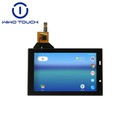Projected capacitive (PCAP) touch panels can be found in ultrasound, EKGs, dialysis equipment, blood gas analysers, AEDs, ultrasonic scalers and other medical and healthcare equipment. While projected capacitive touch panels are now a common component in medical devices and healthcare equipment, there are still some challenges when healthcare equipment is installed in locations such as hospitals or nursing homes.
WIWOTOUCH projected capacitive touch panels are able to operate in spite of the following challenges:
Liquids and gels.
Surgical or examination gloves.
Equipment that generates high frequency noise.
PCAP touch solutions offer a complete range of features that allow your products to face the challenges often faced in the medical field, and the advantages of our touch panels are as follows:
Advanced waterproofing.
Multi-layer surgical/exam glove touch operation.
Passes medical safety regulations IEC 60601-1-2 4th Edition EMC standard.
Touch panels have a wide range of applications in the medical field. Below are a few common applications of touch panels in the medical field:
Medical Equipment Operator Interface: Touch panels can be used as the operator interface of various medical equipment, such as ECG machines, monitors, operating theatre consoles and so on. Medical personnel can intuitively carry out equipment settings, data input and parameter adjustment through the touch screen to improve operational convenience and accuracy.
Electronic medical record system: Touch screen plays an important role in the electronic medical record system. Doctors can use the touch screen to record the patient's condition information, outpatient records, medical instructions, etc., and to access and modify them. The touch screen interface makes it easier for doctors to operate the electronic medical record system, which improves work efficiency and accuracy of information management.
Clinic information display: In the hospital's clinic, the touch screen can be used to display the patient's basic information, the order of consultation, the doctor's consultation time and so on. Patients can check their consultation status through the touch screen, and doctors can also view patient information and queuing status in real time, which improves the efficiency of outpatient process management.
Interactive medical education: touch screen is used in medical education to display anatomical images, case analysis, surgical simulation and other content to provide an interactive learning experience. Students can operate and learn through the touch screen to better understand and apply medical knowledge.
Telemedicine and teleconsultation: Touchscreens can be used as a video communication interface in telemedicine and teleconsultation systems. Doctors and patients can communicate in real-time video, view and share examination results, and conduct remote diagnosis and consultation through the touch screen, providing a convenient way of communication for telemedicine.





